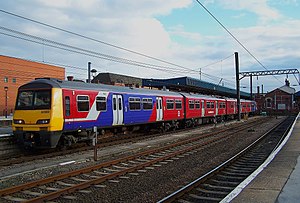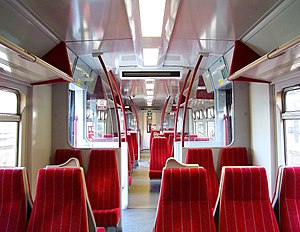British Rail Class 321
| British Rail Class 321 | |
|---|---|

|
|

The refurbished interior aboard a Northern Class 321/9
|
|
| In service | 1988–current |
| Manufacturer | BREL York |
| Family name | BR Second Generation (Mark 3) |
| Number built | 117 trainsets |
| Formation | 4 cars per trainset
|
| Capacity | 321/9: 309 seats per unit |
| Operator(s) | |
| Specifications | |
| Car length | 19.95 m (65 ft 5 in) |
| Width | 2.82 m (9 ft 3 in) |
| Height | 3.78 m (12 ft 5 in) |
| Maximum speed | 100 mph (161 km/h) |
| Weight | Total - 137.9 t (135.7 long tons) |
| Power output | 1,438 hp (1,072 kW) |
| Electric system(s) | 25 kV 50 Hz AC overhead |
| Coupling system | Tightlock coupling compatible - classes 313-322 inclusive |
| Track gauge | 1,435 mm (4 ft 8 1⁄2 in) standard gauge |
The British Rail Class 321 alternating current (AC) electric multiple units (EMU) were built by BREL York in three batches from 1988 to 1991. The design was successful and led to the development of the similar Class 320 and Class 322 units for use by Strathclyde PTE and Stansted Express (now used by Northern) respectively. The British Rail Mark 3 bodyshell design was also used for construction of the Class 456 direct current (DC) units.
The 321s are operated by Greater Anglia, Northern and Great Northern.
Three sub-classes of unit were built. The first two were built for the Network SouthEast sector, whilst the final batch was built for services around Leeds. These trains have been modified by different rail companies who use them, such as Greater Anglia. The modifications include new seats, paintwork, lighting and in carriage announcement boards.
The first batch of 66 EMU trains, built between 1988 and 1990 were classified under TOPS as Class 321/3. Units were numbered in the range 321301-366 and have a maximum speed of 100 mph (161 km/h). Each EMU consisted of four carriages; two outer driving trailers, one of which contained first class seating; an intermediate motor coach with standard class seating only, roof mounted Brecknell Willis High Speed pantograph and four Brush TM2141C traction motors (two per bogie); and an intermediate trailer with standard class seating. The technical description of the formation is DTCO+PMSO+TSO+DTSO. These units were delivered in two groups, with individual vehicles numbered as follows:
...
Wikipedia
